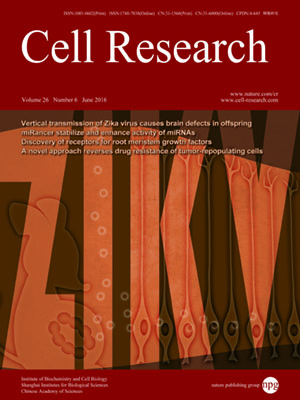
Volume 26, No 6, Jun 2016
ISSN: 1001-0602
EISSN: 1748-7838 2018
impact factor 17.848*
(Clarivate Analytics, 2019)
Volume 26 Issue 6, June 2016: 699-712
RESEARCH HIGHLIGHTS
Cdh1 regulates craniofacial development via APC-dependent ubiquitination and activation of Goosecoid
Rui Shao1,*, Jia Liu2,3,4,*, Guang Yan1, Jinfang Zhang2, Yujiao Han1, Jianfeng Guo2,5, Zhan Xu1, Zhu Yuan2,7, Jiankang Liu3, Marcos Malumbres6, Lixin Wan2,8, Wenyi Wei2 and Weiguo Zou1
1State Key Laboratory of Cell Biology, CAS Center for Excellence in Molecular Cell Sciences, Institute of Biochemistry and Cell Biology, Shanghai Institutes for Biological Sciences, Chinese Academy of Sciences, Shanghai 200031, China
2Department of Pathology, Beth Israel Deaconess Medical Center, Harvard Medical School, Boston, MA 02215, USA
3Center for Mitochondrial Biology and Medicine, The Key Laboratory of Biomedical Information Engineering of Ministry of Education, School of Life Science and Technology and Frontier Institute of Life Science, FIST, Xi'an Jiaotong University, Xi'an, Shanxi 710049, China
4Cardiovascular Research Center, Xi'an Jiaotong University School of Medicine, Xi'an, Shanxi 710061, China
5Department of Obstetrics and Gynecology, Union Hospital, Tongji Medical College, Huazhong University of Science and Technology, Wuhan, Hubei, China
6Cell Division and Cancer Group, Centro National de Investigaciones Oncológicas (CNIO), Madrid, Spain
7State Key Laboratory of Biotherapy and Cancer Center, West China Hospital, Sichuan University/Collaborative Innovation Center of Biotherapy, West China Hospital, Sichuan University, 17 People's South Road, Chengdu, Sichuan 610041, China
8Department of Molecular Oncology, H. Lee Moffitt Cancer Center and Research Institute, Tampa, FL 33612, USA
Correspondence: Weiguo Zou, Tel: +86-21-54921320 E-mail: zouwg94@sibcb.ac.cn; Wenyi Wei, Tel: +1-617-735-2495 E-mail: wwei2@bidmc.harvard.edu; Lixin Wan, Tel: +1-813-745-2824(lixin.wan@moffitt.org)
Craniofacial anomalies (CFAs) characterized by birth defects of skull and facial bones are the most frequent congenital disease. Genomic analysis has identified multiple genes responsible for CFAs; however, the underlying genetic mechanisms for the majority of CFAs remain largely unclear. Our previous study revealed that the Wwp2 E3 ubiquitin ligase facilitates craniofacial development in part through inducing monoubiquitination and activation of the paired-like homeobox transcription factor, Goosecoid (Gsc). Here we report that Gsc is also ubiquitinated and activated by the APCCdh1 E3 ubiquitin ligase, leading to transcriptional activation of various Gsc target genes crucial for craniofacial development. Consistenly, neural crest-specific Cdh1-knockout mice display similar bone malformation as Wwp2-deficient mice in the craniofacial region, characterized by a domed skull, a short snout and a twisted nasal bone. Mechanistically, like Wwp2-deficient mice, mice with Cdh1 deficiency in neural crest cells exhibit reduced Gsc/Sox6 transcriptional activities. Simultaneous deletion of Cdh1 and Wwp2 results in a more severe craniofacial defect compared with single gene deletion, suggesting a synergistic augmentation of Gsc activity by these two E3 ubiquitin ligases. Hence, our study reveals a novel role for Cdh1 in craniofacial development through promoting APC-dependent non-proteolytic ubiquitination and activation of Gsc.
10.1038/cr.2016.51
FULL TEXT | PDF
Browse 2130


